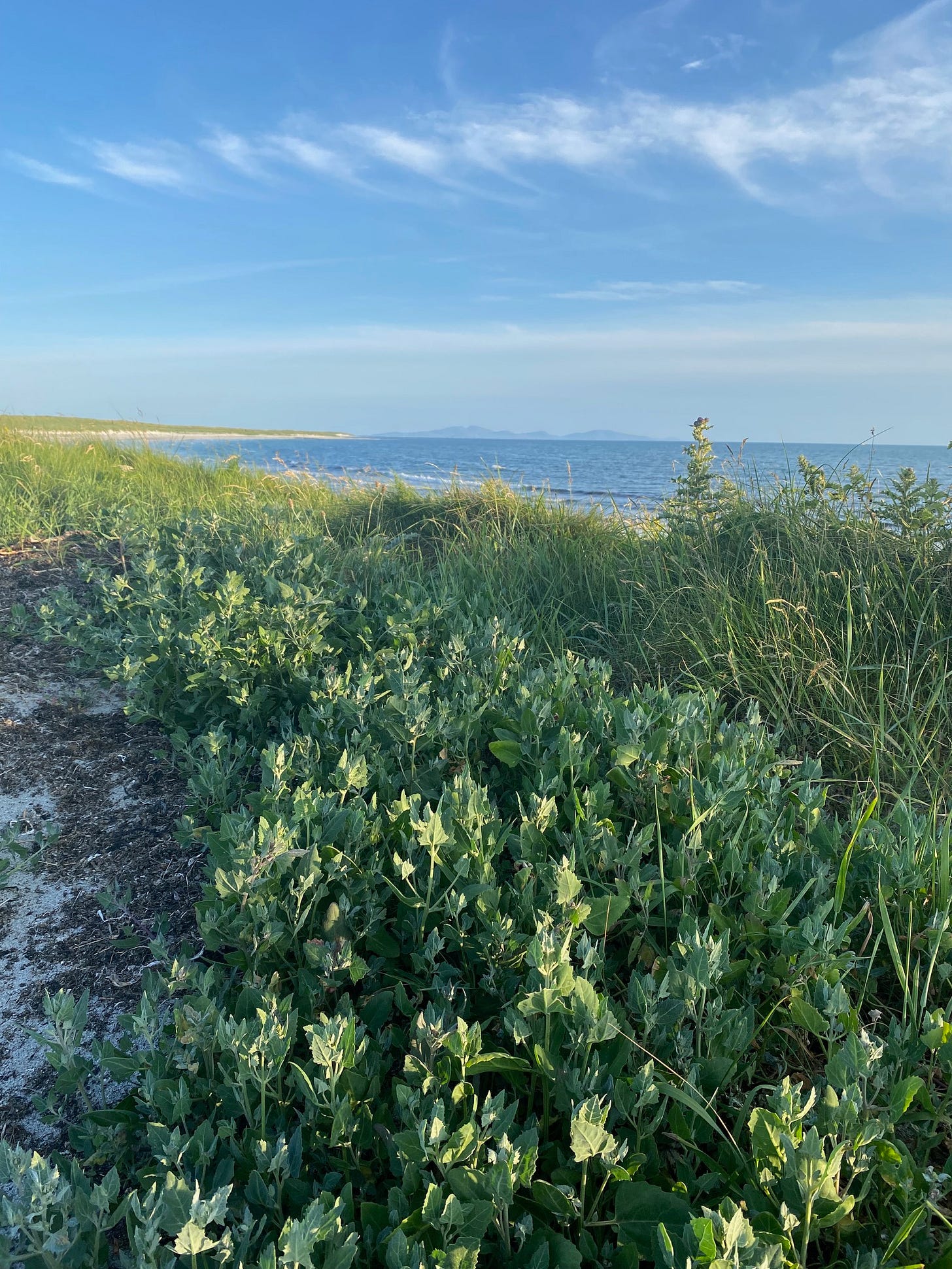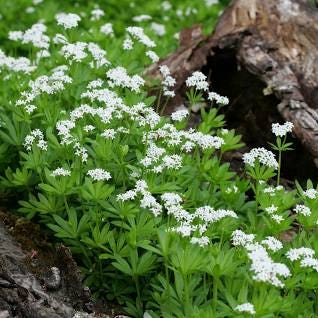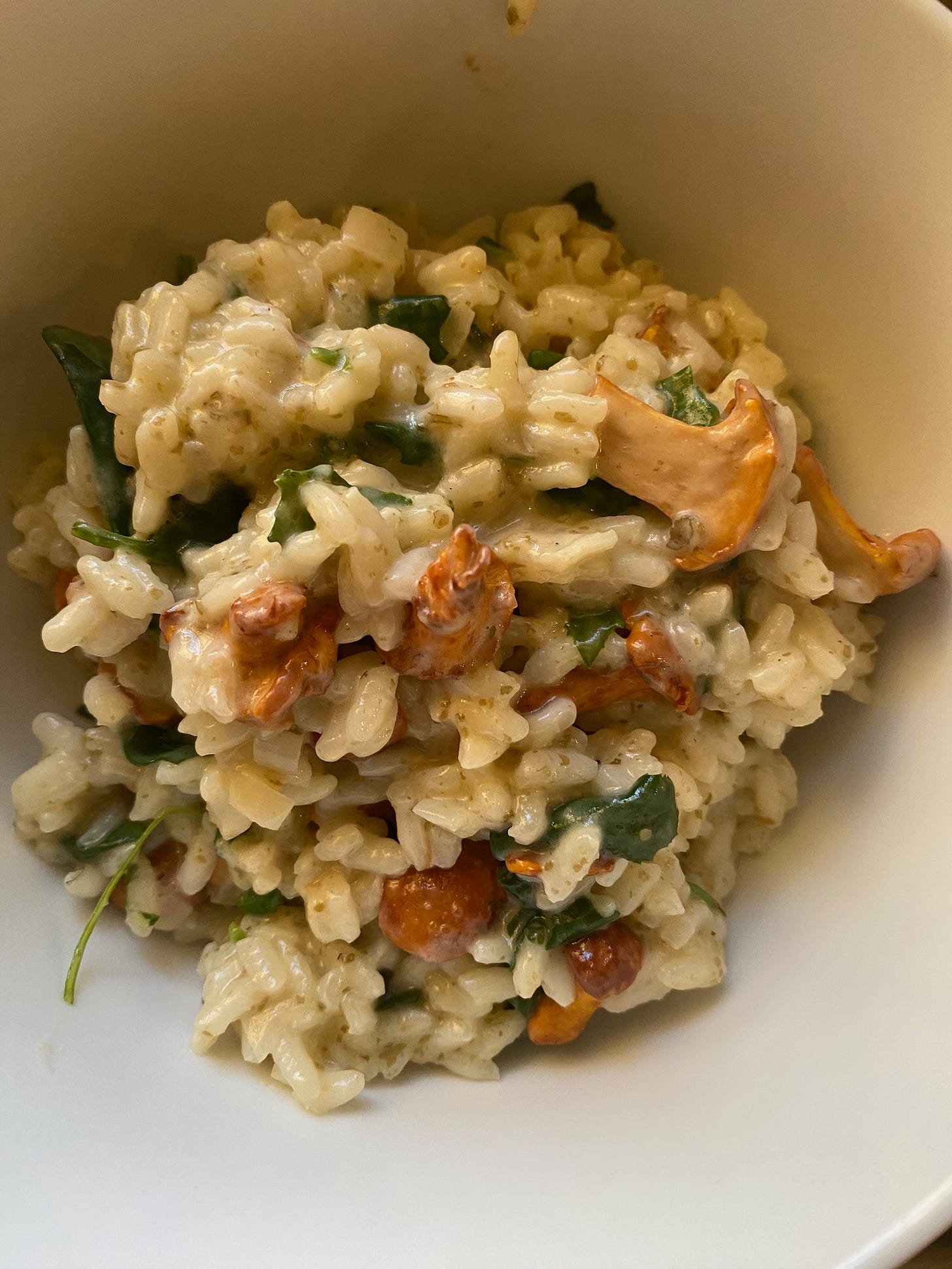Midsummer Fairies and The Feast of Saint John The Baptist
Recipes: Sweet Woodruff Fairy Butter and Orache, Button Chanterelles and Sugar Kelp Risotto

The influence of pagan festivals and folklore is thinly disguised in Christian tradition. Midsummer’s Day celebrated on June 24th was a popular Medieval festival. It follows the summer solstice, the longest day of the year, June 21st. A time of new beginnings, it was marked by dancing and jollity and the banishment of evil spirits. A magical season. A midpoint between sowing and harvesting, in the farmland and garden growing season. June 24th is also the feast day of St John the Baptist contrasting the birth of his cousin, Jesus Christ, six months later in the days of darkness. The flip side of midsummer being the winter solstice. This rather neatly dovetails into the liturgical year and the celebration of Christmas. The winter solstice celebrates the return of the sun, Jesus Christ (Luke 1: 24-37).
The belief in a Fairy kingdom veers from acceptance of fairies in magical activities through to outright hostile disbelief. The concept of ‘Fairyland’ is a gift to poets and writers. Shakespeare tells a tale of fairy trickery in his Midsummer Night’s Dream - although there is an academic argument that the play is set on May Day Eve not Midsummer’s night. Many Beltaine activities and stories are easily muddled into Midsummer themes, so the error is perhaps forgivable. It is on Midsummer’s night the that fairies are said to be seen and this belief continues in spite of the church naming 24th June St John’s Day. In Shakespeare’s time there was regal fairy support in that Elizabeth 1st had an interest in fairies whilst James her successor was fascinated by witchcraft. The unfinished poem Faerie Queene (1590) by Edmund Spenser, an allegorical work expressing the virtues of Elizabeth 1st is aptly named.
The summer solstice festival remains a secular affair There are tales describing the magic of Midsummer: cows talking, stones dancing and visits by spirits of the night. Druids believed that plants gathered at Midsummer had mystical powers. Midsummer Eve is indeed, historically, a time for gathering herbs. The air is fragrant with heavenly scents and hours of darkness are precious few. Wreaths were made and joyous and sorrowful explanations attributed to the manner in which the garlands either shrivelled or indeed, burned. John the Baptist is also connected with herbs and healing, but St John’s Wort so called because it flowered around the Feast of John the Baptist, is attributed with special powers when picked in the early hours of 24th June; and even today it is considered an effective treatment for depressive illness. The anthropologist Sir James Frazer writes, in The Golden Bough, of a belief that cures could take particular effect if the plant was picked on June 23rd. In June, Oak trees reach their summer glory. Celtic mythology tells us that fairies sought comfort under the Oak. In the Treadwell Book of Plant Magic, Christina Harrington writes that Fairies dance around Herne’s oak in Windsor Great Park. Returning to Midsummer folkore, if the left palm is rubbed on oak bark on Midsummer’s Day, it will keep illhealth at bay for the rest of the year. The connection between fairies and the oak is interesting because many of the early Christian churches were founded in Oak groves which had been Pagan places of worship. At Rogationtide, some congregations still pause at a specific oak tree, to read the gospel during the Parish Beating of the Bounds.
Midsummer bonfires cleared the air of other worldly spirits and purified the air from illness. The lighting of bonfires in Midsummer was accompanied by revelry : games, feasting and drinking. The Midsummer bonfire was lit late on June 23rd and activities often extended to St Peter’s Eve (June 28th). These festivities could be problematic - Margo Todd writes in Profane Pastimes and the Reformed Community: The persistence of Popular Festivities in Early Modern Scotland that a bellman was sent through Perth to proclaim that, ‘No market be made on the Sabbath following, which is Midsummer Day.’ Shakespeare’s line in Twelfth Night ‘Why this is very midsummer madness’ (Act 3 Scene 4) is seasonally most appropriate.
Some years ago, I was fortunate to meet Canon Angus MacQueen in his home on the Isle of Barra. We discussed seaweed rather than Fairies or the Little People. My lasting impression of him is as of a man of faith in touch with the seasons. However, here he speaks of wise, musical, Little People who knew how to harness nature. They were happy. The Little People gathered wild ingredients and preserved them for the winter months when they lived underground. Canon MacQueen justifies the changeling (when a baby left under sheaves of corn as the crofters worked was replaced by an elderly old man) and talks of the Little People being bewitched by drink. Is Canon Macqueen describing fairies or simply a community living on the edge. I am grateful to Alasdair McIntosh for reminding me of a quotation by Nan Mackinnon from Vatersay (1981). ‘Yes, about the fairies and all that. They say they are here for a century and away for another century. This is their century away.’ Folk characters have a habit of making a comeback.
There are similarities in both Folklore and Christian themes. Changing seasons are integral in both pastoral rituals and the Church’s Liturgical year. The urge for life is compelling and folk customs help. Many customs are deep rooted in self preservation: fertility and bountiful harvests. Traditions that may have superstitious origins, can acquire a new significance in a world that needs humanity to be more in touch with nature.
WILD MIDSUMMER FEASTING IDEAS
Sweet Woodruff is also known as Lady’s Bedstraw. When dried, it is a sweet smelling strewing herb. It can be found in woods in Midsummer. Sweet Woodruff was used in nosegays and said to be a favourite of the Faerie Queen. I have an adaptation of Mrs Beaton’s Fairy Butter in the Forager’s Kitchen Handbook. It works well with sweet woodruff – Midsummer Fairy Butter.
My second Midsummer recipe includes three wild ingredients that can be gathered in June and then popped into a risotto: orache, button chanterelles and the seaweed, sugar kelp.

MIDSUMMER RISOTTO
Serves 3-4
40g butter
Tablespoon olive oil
Small shallot diced
Heaped tablespoon dried sugar kelp (or laver)
300g risotto rice
Litre warm water
100g small chanterelles that have been briefly cooked in butter.
2 large handfuls washed, orache (tiny leaves)
Tablespoon soft cream cheese.
Heat the butter and oil in a shallow wide pan over a low heat. Soften the shallot without colouring.
Add the rice and sugar kelp and stir well to coat the rice with butter and oil.
Gradually add the warm water, a ladle at a time. Continue stirring and adding water until the rice is cooked. You may need more water. Add the orache for the last 2-3 minutes of cooking time.
Add the cooked chanterelles and cream cheese. Season well and enjoy St John the Baptist’s Midsummer Feast.






“I serve the fairy queen,
To dew her orbs upon the green.
The cowslips tall her pensioners be:
In their gold coats spots you see;
Those be rubies, fairy favours,
In those freckles live their savours:
I must go seek some dewdrops here
And hang a pearl in every cowslip's ear.
Farewell, thou lob of spirits; I'll be gone:
Our queen and all our elves come here anon.”
Great post as always.
(If you believe in Faeries - clap your hands.)
❤️
Risotto is a dish that you can truly make your own. So easy to share - an opportunity to give a little bit of yourself to others ♥️